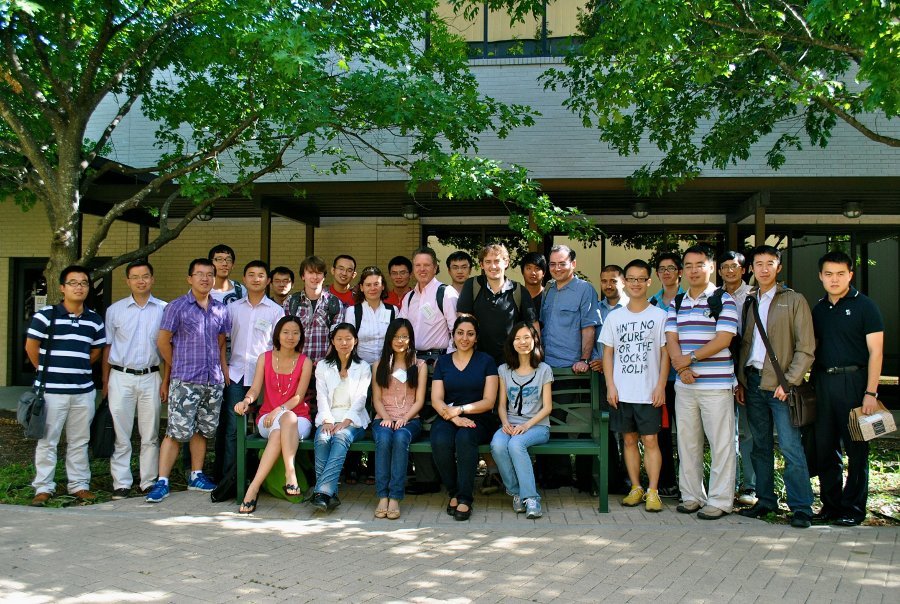Austin 2012

Agenda[edit]
| Day 1: Friday, July 20, 2012 | ||
|---|---|---|
| 8:00-9:00 | Coffee/pastries/installation | |
|
Bring your laptop and get help getting Madagascar installed. | ||
| 9:00-10:15 | Introduction (Sergey Fomel) | |
|
The Madagascar open-source project has been in public existence for six years. Madagascar provides a complete environment for organizing one's research, from new software development to running computational experiments to publishing the computational results in papers and reports, archiving them for future usage, and sharing them with colleagues or sponsors. The introductory presentation will describe the history of the project, the Madagascar components and design principles, and plans for future development.
| ||
| 10:15-10:30 | break | |
| 10:30-12:00 | Introductory exercise (Siwei Li) | |
|
This lecture will be interactive: you will be provided some scratch scripts for modification during the presentation. Feel free to stop the lecturer whenever you have trouble fulfilling a task before he proceeds to a higher level knowledge. The main task is to familiarize you with basic SConstruct interfaces for function calling and graphic plotting, as well as a first glance on typical Madagascar C code.
| ||
| 12:00-1:00 | Lunch | |
| 1:00-2:30 | Madagascar fundamentals: RSF file format, command-line programs, and SCons (Sergey Fomel) | |
|
Madagascar programs operate on data stored in RSF (regularly sampled) data format. They can be run from the command line, Unix shell scripts, or (more conveniently) using SCons. I will describe the rational behind this design and the basics of working with Madagascar.
| ||
| 2:30-2:45 | break | |
| 2:45-3:30 | Vplot graphics (Parvaneh Karimi) | |
|
In this lecture you will get familiar with representing RSF dataset graphically using Madagascar tools and also with creating figures in reproducible fashion for papers and presentations.
| ||
| 3:30-5:00 | Seismic Field Data Processing (Salah Alhadab) | |
|
In this session we will demonstrate how to use Madagascar to process marine data. I will explain how to use parabolic Radon Transform to do multiple attenuation step by step. It will be a hands on tour.
| ||
| 5:30-8:30 | Wine reception and dinner at Maggiano's | |
| Day 2: Saturday, July 21, 2012 | ||
|---|---|---|
| 8:00-9:00 | Coffee/pastries/installation | |
|
Bring your laptop and get help getting Madagascar installed. | ||
| 9:00-12:00 | Seismic wavefield imaging and Writing Research Papers (Paul Sava) | |
|
The theoretical part of this module provides an overview of reverse-time imaging methodology applied to wavefield seismic data. The main technique discussed is reverse-time migration developed under the single-scattering assumption. The applied part demonstrates this technique on a complex geologic model using Madagascar codes in a fully reproducible setup. We will conclude by generating reproducible documents constructed using LaTeX.
| ||
| 12:00-1:00 | Lunch | |
| 1:00-2:30 | Developing your own programs in Madagascar (Jingwei Hu) | |
|
There are many programs already built into the Madagascar project, but if you use Madagascar long enough you will eventually run into a problem that you cannot solve using only provided codes. Fortunately, Madagascar has a variety of programming language APIs already built, that allow you to: design, code, and integrate your programs into the Madagascar framework. This session will discuss an overview of the Madagascar APIs, and then focus in particular on the C++ APIs. By the end of the session, you should have a good starting point for developing your own codes, and adding them to the growing library of open-source software available in Madagascar.
| ||
| 2:30-2:45 | break | |
| 2:45-3:30 | Parallel processing with Madagascar (Esteban Díaz) | |
|
Today's HPC (High Performance Computing) systems provide us with great calculation power. Therefore, we should be able to use our resources at its maximum extent via parallelization. Madagascar provides us with several options to improve our computing efficiency: using SCons, at the source code level or both. We will measure the performance of each approach using a simple example. After this presentation, you should be able to exploit the resources of your system.
| ||
| 3:30-4:15 | Contributing your code to Madagascar (Sergey Fomel) | |
|
The final presentation will describe different ways of participating in the Madagascar community and contributing to the development.
| ||
| 4:15-5:00 | Discussion | |
|
Open Q&A session and discussions on the future development of Madagascar. | ||
Location[edit]
Room ROC 1.603
Texas Advanced Computing Center
The University of Texas at Austin
Address
- J.J. Pickle Research Campus, Building 196
- 10100 Burnet Road (R2200)
- Austin, Texas 78758-4445, USA
- Directions
- Nearby hotels
Dinner Location[edit]

Maggiano's
- 10910 Domain Drive, Suite 100
- Austin, Texas 78758
- Directions
Host Organization[edit]
Bureau of Economic Geology
The University of Texas at Austin
Speakers[edit]
- Salah Alhadab joined Saudi Aramco as Geophysical System Analyst in 2003, after receiving a BS degree in Computer Science. He worked at the Seismic Data Processing Support Group in Saudi Aramco before coming to the University of Texas at Austin, where he is pursuing an MS degree.
- Esteban Díaz is a graduate student at the Center for Wave Phenomena at Colorado School of Mines, currently enrolled in the M.Sc. program. He is a geophysical engineer (2008) from the Universidad Simón Bolívar. He has worked in seismic data processing and depth imaging. His research interests are image processing, depth imaging, migration velocity analysis and geostatistics.
- Sergey Fomel has been working at the Bureau of Economic Geology at the University of Texas at Austin since 2002 and currently has an Associate Professor appointment, jointly with the Department of Geological Sciences. He received a Ph.D. in Geophysics from Stanford University in 2001 and worked previously at the Institute of Geophysics in Novosibirsk, Russia, and the Lawrence Berkeley National Laboratory. Sergey started work on Madagascar (at that time named RSF for Regularly Sampled Format) in 2003. http://www.jsg.utexas.edu/researcher/sergey_fomel/
- Jingwei Hu is a postdoctoral fellow at the Institute for Computational Engineering and Sciences (ICES), the University of Texas at Austin. Jingwei received her BS degree (2006) in computational mathematics from Peking University, China, and her PhD degree (2011) in mathematics from the University of Wisconsin-Madison. Her interests are numerical methods and applied analysis for kinetic theory, conservation laws, quantum mechanics, high frequency waves, and seismic imaging. http://users.ices.utexas.edu/~hu/
- Parvaneh Karimi received her BS in Mining Engineering from Shahid Bahonar University, Iran, and her master's degree in Geophysics (Exploration Seismology) from the University of Tehran. She is currently a Ph.D. candidate at the University of Texas at Austin.
- Siwei Li graduated from Peking University with a Bachelor's Degree in Geophysics and is currently pursuing a Ph.D. degree at the University of Texas at Austin.
- Paul Sava is an Associate Professor of Geophysics and a member of the Center for Wave Phenomena at Colorado School of Mines. He holds an Engineering degree in Geophysics (1995) from the University of Bucharest, an M.Sc. (1998) and a Ph.D. (2004) in Geophysics from Stanford University where he was a member of the Stanford Exploration Project. His research interests are in wavefield seismic imaging, stochastic imaging and inversion, computational methods for wave propagation, numeric optimization and high performance computing. http://newton.mines.edu/paul/home.php
Neighbor Conferences[edit]
- SciPy 2012, Scientific Computing with Python
